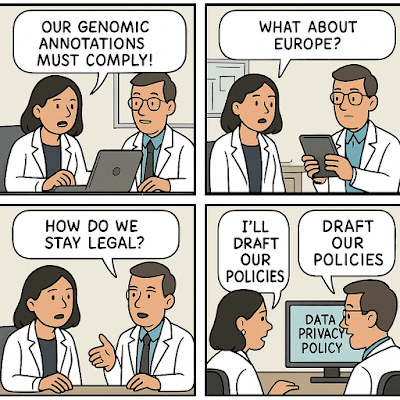Genomic Data Annotation Compliance under HIPAA and GDPR
Genomic Data Annotation Compliance under HIPAA and GDPR
As genomic data plays a pivotal role in personalized medicine and biotech innovation, the need for secure, compliant handling of this information has never been more urgent.
Genomic data annotation—the process of labeling genetic sequences with functional, clinical, or contextual meaning—poses unique privacy and regulatory challenges.
In the U.S., HIPAA governs protected health information (PHI), while in Europe, GDPR covers personally identifiable data—including certain types of genetic data.
This article explores how healthcare companies, researchers, and SaaS platforms can ensure their annotation workflows remain compliant across borders.
📌 Table of Contents
- What is Genomic Data Annotation?
- How HIPAA Classifies Genetic Data
- GDPR Protections for Genomic Information
- Cross-Jurisdictional Compliance Strategies
- Conclusion
🧬 What is Genomic Data Annotation?
Annotation involves interpreting raw genetic sequences, such as identifying genes, regulatory elements, and mutations.
It connects sequence data to known functions, phenotypes, and clinical outcomes.
This is essential in drug discovery, diagnostics, rare disease screening, and personalized cancer therapy.
But the more detailed the annotation, the more privacy-sensitive the data becomes.
🛡️ How HIPAA Classifies Genetic Data
Under HIPAA, genetic data qualifies as Protected Health Information (PHI) when it is tied to an individual and created or received by a healthcare entity.
De-identification, according to HIPAA’s Safe Harbor or expert determination methods, is required before sharing genomic annotations for research.
However, re-identification risks—especially with public sequence databases—make compliance tricky.
📜 GDPR Protections for Genomic Information
GDPR classifies genetic data as a “special category” requiring heightened protections.
Processing such data demands explicit consent, or must be justified under specific legal bases like public health or research exemptions.
Controllers must maintain detailed documentation, data processing agreements, and conduct Data Protection Impact Assessments (DPIAs).
Transfer of genomic data from the EU to the U.S. requires Standard Contractual Clauses or other approved mechanisms.
🌐 Cross-Jurisdictional Compliance Strategies
For multinational research consortia, the following steps are critical:
Use federated learning or differential privacy in genomic annotation models
Deploy anonymization tools like ARX or Synthea for synthetic genomes
Maintain clear records of consent and data lineage
Ensure cloud providers meet HIPAA/HITECH and GDPR requirements
Organizations should consider appointing a cross-border Data Protection Officer (DPO) specializing in bioinformatics compliance.
🧩 Conclusion
Genomic data annotation can save lives—but it must be done with care.
HIPAA and GDPR both impose strict boundaries on how, when, and why personal genetic information is processed and shared.
With the right data governance and ethical AI practices, life sciences firms can innovate responsibly while protecting patients and participants.
🔗 Related Resources
Keywords: genomic data annotation, HIPAA compliance, GDPR genetic data, bioinformatics privacy, cross-border data protection
